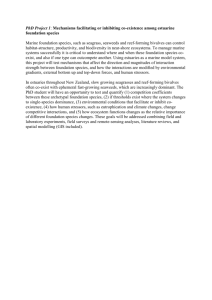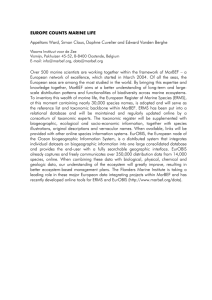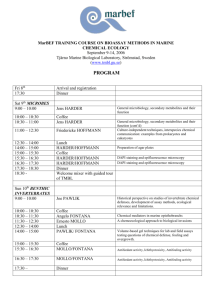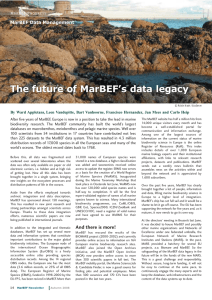Report of the MarBEF TRAINING COURSE ON BIOASSAY
advertisement
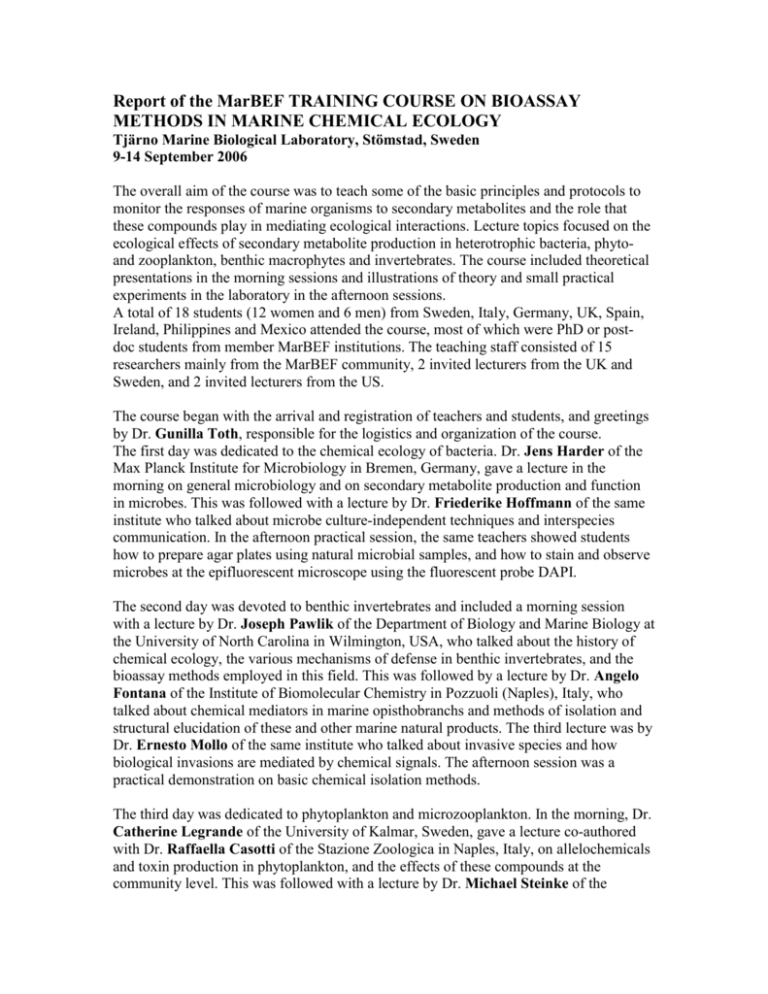
Report of the MarBEF TRAINING COURSE ON BIOASSAY METHODS IN MARINE CHEMICAL ECOLOGY Tjärno Marine Biological Laboratory, Stömstad, Sweden 9-14 September 2006 The overall aim of the course was to teach some of the basic principles and protocols to monitor the responses of marine organisms to secondary metabolites and the role that these compounds play in mediating ecological interactions. Lecture topics focused on the ecological effects of secondary metabolite production in heterotrophic bacteria, phytoand zooplankton, benthic macrophytes and invertebrates. The course included theoretical presentations in the morning sessions and illustrations of theory and small practical experiments in the laboratory in the afternoon sessions. A total of 18 students (12 women and 6 men) from Sweden, Italy, Germany, UK, Spain, Ireland, Philippines and Mexico attended the course, most of which were PhD or postdoc students from member MarBEF institutions. The teaching staff consisted of 15 researchers mainly from the MarBEF community, 2 invited lecturers from the UK and Sweden, and 2 invited lecturers from the US. The course began with the arrival and registration of teachers and students, and greetings by Dr. Gunilla Toth, responsible for the logistics and organization of the course. The first day was dedicated to the chemical ecology of bacteria. Dr. Jens Harder of the Max Planck Institute for Microbiology in Bremen, Germany, gave a lecture in the morning on general microbiology and on secondary metabolite production and function in microbes. This was followed with a lecture by Dr. Friederike Hoffmann of the same institute who talked about microbe culture-independent techniques and interspecies communication. In the afternoon practical session, the same teachers showed students how to prepare agar plates using natural microbial samples, and how to stain and observe microbes at the epifluorescent microscope using the fluorescent probe DAPI. The second day was devoted to benthic invertebrates and included a morning session with a lecture by Dr. Joseph Pawlik of the Department of Biology and Marine Biology at the University of North Carolina in Wilmington, USA, who talked about the history of chemical ecology, the various mechanisms of defense in benthic invertebrates, and the bioassay methods employed in this field. This was followed by a lecture by Dr. Angelo Fontana of the Institute of Biomolecular Chemistry in Pozzuoli (Naples), Italy, who talked about chemical mediators in marine opisthobranchs and methods of isolation and structural elucidation of these and other marine natural products. The third lecture was by Dr. Ernesto Mollo of the same institute who talked about invasive species and how biological invasions are mediated by chemical signals. The afternoon session was a practical demonstration on basic chemical isolation methods. The third day was dedicated to phytoplankton and microzooplankton. In the morning, Dr. Catherine Legrande of the University of Kalmar, Sweden, gave a lecture co-authored with Dr. Raffaella Casotti of the Stazione Zoologica in Naples, Italy, on allelochemicals and toxin production in phytoplankton, and the effects of these compounds at the community level. This was followed with a lecture by Dr. Michael Steinke of the Department of Biological Sciences of the University of Essex, UK, on biogenic gas production in certain phytoplankton species during micro- and macrozooplankton grazing. The afternoon practical session included use of vital stains such as SYTOX green and other probes to distinguish live from dead phytoplankton cells, and microzooplankton grazing experiments with detection of DMS production in grazed Emiliania huxleyi. The fourth day was dedicated to seaweeds with a morning lecture by Dr. Mark Hay of the Georgia Institute of Technology in Atlanta, USA, on the chemical ecology of seaweeds and on ecologically relevant bioassays in this field. This was followed with a lecture by Dr. Philippe Potin of the Station Biologique de Roscoff, France, who discussed bioassay methods to study induced defenses and resistance in seaweeds. This was followed with a lecture by Dr. Gunilla Toth of the Tjärnö Marine Laboratory of the University of Goteborg, Sweden, who talked about bioassay methods to study plantherbivore interactions. The afternoon session included a boat excursion followed by a practical demonstration on the use of antioxidant ROS tests to study metabolite toxicity in seaweeds. The fifth day was devoted to zooplankton and included a lecture by D. Adrianna Ianora of the Stazione Zoologica in Naples, Italy, who talked about bioassay methods in studies on the effects of dinoflagellate toxins on copepods. This was followed with a lecture by Dr. Serge Poulet of the Station Biologique de Roscoff, France, on the effects of diatom metabolites on copepods. The third lecture was by Dr. Maarten Boersma of the Helgoland Marine Station of the Alfred Wegener Institute, Germany, who talked about explanatory models in marine chemical ecology and defense strategies in the pelagic environment. The afternoon session included a lecture and movie on various toxicological tests in marine invertebrates by Dr. Giovanna Romano of the Stazione Zoologica in Naples, Italy, as well as a practical demonstration on the use of fluorescent probes such as TUNEL to detect cell death and apoptosis in invertebrates. The course was an overall success, the students gave positive feedbacks and the teachers were all very satisfied with the level of attendance. The presentations given by the teachers are now available as pdf files on the ROSEMEB website.
